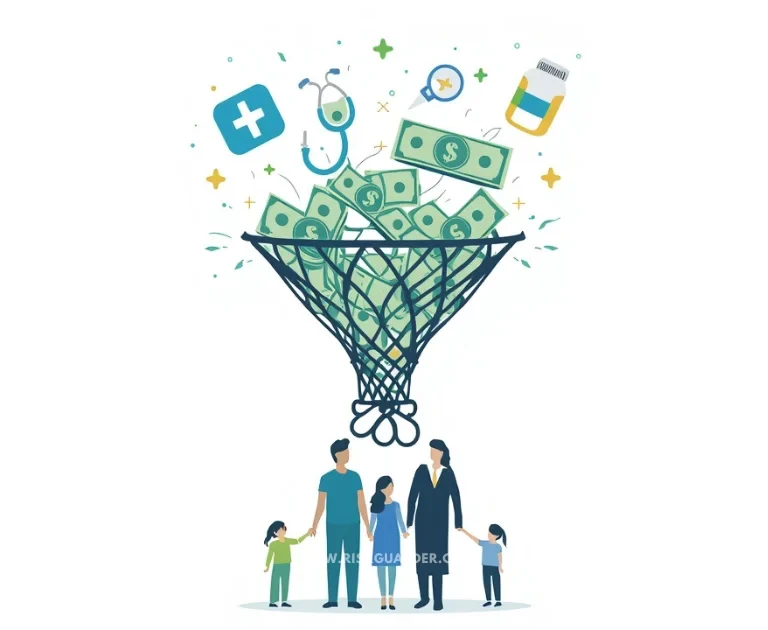Welcome to one of the most confusing parts of becoming an adult. Suddenly, you’re supposed to be an expert on things like deductibles, liability, and premiums. It’s confusing, and nobody gives you a manual. This is that manual.
We’ll walk you through every type of insurance for young adults you need to think about in your 20s, step-by-step. Whether you just turned 18, graduated college, landed your first real job, or are approaching that dreaded 26th birthday when you age out of your parents’ health plan, this guide breaks down exactly what coverage you need, when you need it, and how to get it without overpaying.
Our analysis is based on the official RiskGuarder Review Methodology, which evaluates insurance products using data from A.M. Best financial strength ratings, NAIC complaint indices, and J.D. Power customer satisfaction studies. We’ve synthesized insights from leading authorities including Healthcare.gov, industry experts, and mental health organizations to create the most comprehensive resource for young adults navigating insurance for the first time.
Your Insurance Journey Through Your 20s: The Timeline
Understanding insurance for young adults becomes much simpler when you view it as a journey tied to specific life milestones. Here’s your roadmap:
Ages 18-25: The Foundation Years During this period, your primary focus should be on health insurance for 20s (typically staying on your parents’ plan thanks to the Affordable Care Act) and auto insurance for students if you’re driving. These are your non-negotiables, the baseline protections every young adult needs.
First Apartment: The Independence Milestone Moving into your first apartment triggers the need for renters insurance for first apartment. This is often overlooked but incredibly important and surprisingly affordable, typically costing between $15-25 per month for comprehensive coverage.
First “Real” Job: The Benefits Awakening Landing your first career-track position opens up a new world of employer-sponsored benefits. This is when you need to understand how to get insurance after college through your workplace, including health insurance, disability insurance, and potentially life insurance options. This is your opportunity to build a comprehensive protection portfolio at group rates.
Turning 26: The Health Insurance Cliff This is a critical transition point. The day you turn 26, you lose eligibility for your parents’ health insurance plan. You need to understand how to get health insurance after turning 26 well before your birthday arrives. Missing this deadline can leave you uninsured and facing significant financial risk.
Getting Married or Buying a Home: The Commitment Phase Major life commitments trigger the need to increase your life insurance coverage and potentially transition from renters to homeowners insurance. Your insurance needs evolve as your responsibilities grow.
Table of Contents
The #1 Priority: Health Insurance Explained

Let’s be direct: health insurance for 20s is your most important coverage. A single emergency room visit without insurance can cost thousands of dollars. A serious illness or accident can result in six-figure medical bills that could derail your financial future before it even begins.
A single ER visit without insurance? That’ll be $5,000, please. Break your leg skiing? Cool, that’s $20,000. Get seriously sick? We’re talking six figures. So yeah, health insurance isn’t optional.
The good news? You’ve actually got some decent options.
Option 1: Staying on Your Parents’ Plan (The Under-26 Rule)
This is a federal right thanks to the Affordable Care Act, as explained on the official Healthcare.gov website. Under the Affordable Care Act under 26 provision, you can remain on your parents’ health insurance plan until the day you turn 26, regardless of whether you’re married, living with your parents, enrolled in school, or financially independent.
This is usually your best bet because your parents are already paying for it, and you get all the benefits without the hefty premium. It’s basically the insurance equivalent of living rent-free.
But here’s what you need to know:
The free ride ends the day you turn 26. Mark your calendar, set an alarm, tattoo it on your arm – whatever it takes to remember this date. You don’t want to suddenly find yourself uninsured.
If you’ve moved far from home, check if your parents’ plan works where you live. Some plans have limited networks, which means you might have trouble finding doctors in your area.
Understand how the deductible works. That’s the amount you have to pay out of pocket before insurance kicks in. On a family plan, everyone’s expenses count toward the same deductible, so you’re sharing it with your parents and siblings.
Option 2: Getting Your Own Plan (After 26 or If You’re Independent)
Once you age out of your parents’ plan or if you need independent coverage earlier, you have three main pathways to health insurance for 20s:
Through Your Job: If you work full-time for a decent-sized company, they’ll offer health insurance. This is usually your best bet because your employer pays a chunk of the premium, so it’s cheaper for you. When you’re looking at plans, pay attention to how much comes out of your paycheck each month, what the deductible is (lower is better), and whether your doctors are “in network” (insurance-speak for “covered”).
The ACA Marketplace: Head over to Healthcare.gov and you can shop for plans on your own. They’re organized by metal tiers – Bronze, Silver, Gold, Platinum. Bronze plans have cheap monthly payments but you pay more when you actually use them. Platinum plans are the opposite. And here’s the cool part: depending on what you earn, you might qualify for discounts that make these plans way more affordable. You can usually only sign up during open enrollment (November through January), but big life changes like turning 26 give you a special pass to enroll anytime.
Short-Term Plans: These are like the band-aids of health insurance. They’ll cover you temporarily if you’re between jobs or waiting for your work insurance to start, but they’re not great long-term. They don’t have to cover pre-existing conditions or a lot of important stuff, and they’re more likely to deny your claims. Use them only as a last resort.
Don’t Sleep on Mental Health Coverage
Real talk for a second: your 20s can be rough. You’re figuring out who you are, dealing with career stress, maybe struggling with anxiety or depression. That’s totally normal, and your health insurance actually covers therapy and counseling.
Organizations like The JED Foundation have tons of resources to help you understand and use these benefits.
Your insurance covers:
Therapy sessions with actual licensed professionals – counselors, psychologists, psychiatrists, the works.
Treatment for substance abuse issues.
Mental health check-ups at no cost to you.
Seriously, if you’re struggling, don’t tough it out. Your insurance probably covers this stuff with just a small copay. There’s zero shame in taking care of your mental health – it’s just as important as getting your broken arm fixed.
Your First “Adult” Policies: Auto & Renters Insurance
Alright, so health insurance is sorted. Now let’s talk about the other two types of insurance you’ll probably need as you venture into the real world.

Renters Insurance: The Most Underrated Coverage
Here’s a fun fact that’ll blow your mind: only about 37% of renters have renters insurance. That means most people are one apartment fire away from losing everything they own with zero compensation. Don’t be that person.
Renters insurance is ridiculously cheap – we’re talking $15-25 a month – and it’s honestly one of the best deals in insurance.
Here’s what it does:
Protects Your Stuff: If your apartment gets robbed, catches fire, or a pipe bursts and ruins everything, renters insurance pays to replace it all. And before you say “I don’t have that much stuff,” add it up. Your laptop, phone, TV, clothes, furniture, kitchen stuff… you’re probably looking at $20,000-30,000 worth of belongings. That’s a lot to lose.
Covers Your Butt If Someone Gets Hurt: Say a friend trips in your apartment and breaks their wrist. Or you accidentally start a fire that damages the building. Without insurance, they could sue you for everything you’ve got. With renters insurance, you’re covered for up to $100,000 (or more if you want).
Pays for a Hotel If Your Place Becomes Unlivable: If there’s a fire and you can’t stay in your apartment while it’s being fixed, renters insurance covers your hotel, meals, and other expenses. Pretty sweet, right?
A lot of landlords now require renters insurance, but even if yours doesn’t, get it anyway. It’s cheap peace of mind. When you’re shopping around, look at the deductible (how much you pay before insurance kicks in) and whether it covers “replacement cost” (pays to buy new stuff) or “actual cash value” (pays what your old, used stuff was worth). Always go for replacement cost.
Auto Insurance: Maximizing Your Discounts
Auto insurance for students and young professionals is notoriously expensive because statistically, drivers under 25 have higher accident rates. However, you can significantly reduce your premiums by taking advantage of available discounts and shopping strategically.
Key discounts for young adults:
Good Student Discount: If you’re enrolled in school and maintain a B average or higher, most insurers offer a 10-25% discount. This discount recognizes that responsible students tend to be responsible drivers.
Defensive Driver Course: Completing an approved defensive driving course can earn you a 5-15% discount and the course often costs less than $50 online.
Telematics Programs: Apps like Progressive’s Snapshot or State Farm’s Drive Safe & Save monitor your driving habits (speed, braking, time of day) and can reduce your premium by up to 30% if you demonstrate safe driving patterns.
Multi-Policy Discount: Bundling your auto insurance with renters insurance from the same company typically saves 10-25% on both policies.
When you’re comparing quotes, don’t just look at the price. Check out the company’s ratings and customer reviews. You want a company that’ll actually pay out when you need them and won’t make you jump through a million hoops to file a claim.
“Future You” Insurance: Life & Disability
Alright, this is where most young people check out. Life insurance? Disability insurance? “I’m 25 and healthy – why would I need that?”
I get it. But hear me out.
Disability Insurance: Protecting Your Most Valuable Asset
Here’s something that’ll make you think: your ability to earn money over the next 40 years is worth way more than anything you own. Like, millions of dollars more. And disability insurance protects that.
According to the Social Security Administration, more than one in four 20-year-olds will become disabled before they retire. That’s not just old people stuff – we’re talking car accidents, sports injuries, unexpected illnesses, all kinds of things that can happen to anyone.
Imagine not being able to work for six months. How would you pay rent? Buy groceries? Keep up with your bills? That’s what disability insurance is for.
There are two types:
Short-Term Disability: Covers you for a few months if you can’t work. Usually costs $10-30 a month and replaces about 60-70% of your paycheck. A lot of employers offer this as an optional benefit.
Long-Term Disability: This is the important one. It pays you if you’re disabled for years or even until retirement. If your employer offers it, sign up – it usually only costs 1-3% of your salary. If not, you can buy it yourself, though it’ll cost more.
When you’re looking at disability insurance, check what counts as “disabled.” The best policies pay out if you can’t do your specific job (called “own occupation”). Cheaper policies only pay if you can’t do any job at all, which is a much higher bar to clear.
Life Insurance: Locking in Low Rates
As experts at Ethos explain, getting life insurance when you’re young and healthy is the cheapest it will ever be. This is a smart move if you have student debt, a partner, or just want to lock in a low rate for life.
Why consider life insurance as a first time life insurance buyer in your 20s?
Student Loan Protection: If you have private student loans with a co-signer (typically a parent), your death doesn’t eliminate that debt. Your co-signer becomes responsible for the full balance. A term life insurance policy equal to your loan balance protects them from this burden.
Income Replacement for Dependents: If you’re married, have children, or anyone relies on your income, life insurance ensures they’re financially protected if you die unexpectedly.
Guaranteed Insurability: Buying life insurance while you’re young and healthy locks in low premiums. If you develop health conditions later, insurance becomes much more expensive or potentially unavailable. A 25-year-old non-smoker might pay $15-25 per month for a $500,000 20-year term life insurance policy, while a 40-year-old with the same coverage could pay $50-80 per month.
For most people in their 20s, term life insurance is the way to go. You pick a time period (like 20 years), pay the same amount every month, and if you die during that time, your beneficiaries get the payout. It’s simple and affordable.
Whole life insurance builds up cash value over time, but it costs 5-10 times more. Unless you’ve got a specific reason to go that route, stick with term.
When evaluating life insurance companies, prioritize those with A.M. Best ratings of A or higher, indicating superior financial strength and ability to pay claims. Review the NAIC complaint index to identify companies with fewer customer disputes. A complaint index of 1.0 is average, below 1.0 is better than average, and above 1.0 indicates more complaints than expected.
The Young Adult’s Insurance Checklist

Use this actionable checklist to ensure you have appropriate coverage based on your current life stage:
✅ Health Insurance Status Check: Am I currently on a parent’s plan or my own? If on a parent’s plan, when do I turn 26? Have I researched my options for coverage after aging out? If employed, have I compared my employer’s plan to staying on my parents’ plan? Do I understand my current deductible, out-of-pocket maximum, and provider network?
✅ Auto Insurance Optimization: Have I asked my insurer about all available discounts (good student, defensive driver, telematics, multi-policy)? Have I compared quotes from at least three companies in the past year? Are my liability limits adequate ($100,000/$300,000 minimum recommended)? Does my insurer have strong financial ratings and customer satisfaction scores?
✅ Renters Insurance Verification: Do I have renters insurance? (If you rent, the answer should be yes). Does my policy provide replacement cost or actual cash value coverage? Is my coverage limit sufficient to replace all my belongings? Have I documented my possessions with photos or video for potential claims?
✅ Disability Insurance Assessment: Does my employer offer short-term and long-term disability insurance? If offered, have I enrolled? If not offered or if I’m self-employed, have I researched individual disability insurance policies? Do I understand how much of my income would be replaced and for how long?
✅ Life Insurance Evaluation: Do I have anyone who depends on my income (spouse, children, aging parents)? Do I have private student loans with a co-signer? Have I gotten quotes for term life insurance to compare costs? If I have employer-sponsored life insurance, is the coverage amount sufficient for my needs?
Frequently Asked Questions
How much does health insurance cost for a 25-year-old?
It depends on a bunch of stuff – where you live, what kind of plan you get, whether it’s through work or on your own. Through your job, you’ll probably pay $50-150 a month (your employer covers the rest). On the marketplace, you might see $200-400 a month for a decent plan, but subsidies can bring that way down – sometimes to almost nothing if you don’t make much money.
Do I need renters insurance if I don’t own expensive things?
Okay, so here’s the thing everyone misses: renters insurance isn’t really about protecting your thrift store couch and your hand-me-down TV. I mean, yeah, it does that too, but the real MVP here is liability coverage.
Picture this: your friend trips over your rug, breaks their ankle, and decides to sue you. Or you fall asleep with a candle burning and accidentally start a fire that damages the whole building. Without renters insurance, you’re personally on the hook for potentially tens of thousands of dollars. With renters insurance? That’s their problem to deal with, not yours. And it costs like $15-20 a month – less than your Netflix subscription. Just get it already.
What happens if I miss the deadline to get health insurance after turning 26?
Okay, don’t panic, but also… kinda panic a little? If you miss your 26th birthday deadline, you’re basically stuck without insurance until the next open enrollment period, which doesn’t roll around until November. That’s a looong time to be crossing your fingers that you don’t get sick or injured.
The only way out is if something major happens – like getting married, having a baby, or landing a new job that offers insurance. Otherwise, you’re paying full price for every doctor visit, prescription, and emergency out of your own pocket.
Pro tip: Start setting phone reminders about three months before the big 2-6. Future you will thank present you big time.
Is disability insurance really necessary in my 20s when I’m healthy?
I love your confidence, I really do. But here’s the brutal truth: most disabilities don’t happen because you got old and your body gave out. They happen because life is random and chaotic. You could get T-boned by someone running a red light tomorrow. You could wipe out on your bike. You could slip on ice and mess up your back.
None of these things care that you’re young and fit. And disability insurance is dirt cheap when you’re in your 20s – we’re talking maybe 1-2% of your paycheck. Compare that to the absolute nightmare of not being able to work (and earn money) for six months or longer. It’s basically betting a small amount now against a catastrophic loss later. Smart money says get it.
Should I get life insurance if I’m single with no kids?
Depends. Got student loans with a co-signer? Get life insurance to protect them. Want to make sure your funeral doesn’t bankrupt your family? Get a small policy. Planning to get married or have kids eventually? Lock in cheap rates now. But if you’ve got no debt, no dependents, and enough savings to cover your final expenses, you can probably skip it for now.
How do I know if my employer’s health insurance is good?
Check what’s coming out of your paycheck every month. If it’s eating up a huge chunk of your income, that’s a red flag.
Look at the deductible – that’s how much you pay before insurance starts helping. Lower is generally better, but not always (keep reading).
Find the out-of-pocket maximum. This is the most you’d ever pay in a year, even if you get hit by a bus and rack up $200,000 in bills.
Make sure your current doctors are “in-network.” Out-of-network doctors cost way more.
Here’s a plot twist though: if you’re young and healthy and rarely go to the doctor, those high-deductible plans paired with an HSA (Health Savings Account) can actually be genius. You pay less every month, and you get to stash pre-tax money in an account that rolls over year after year. It’s like a retirement account for medical stuff. Just make sure you can actually afford that high deductible if something unexpected happens.
You’ve Got This
Look, I know insurance is boring. I get it. But you know what’s more boring? Being broke because you got hit with a massive medical bill or lost all your stuff in an apartment fire.
This is a huge part of “adulting,” and by reading this guide, you’re already ahead of the game. You understand that insurance for young adults isn’t about buying every policy available; it’s about strategically protecting yourself against the risks that matter most at your current life stage while preparing for future transitions.
Each step builds your safety net and protects you from the kind of financial disasters that can derail your whole life. The money you spend on insurance now is way cheaper than the alternative.
And here’s the thing – your insurance needs will change as your life changes. Review everything once a year, especially after big stuff like graduating, getting a new job, moving, getting married, or having kids. What works for you now might not work in five years, and that’s okay.
At RiskGuarder, we’re here to help you figure this stuff out without all the confusing jargon and sales pitches. Insurance is complicated, but making smart decisions doesn’t have to be.
Now go forth and adult responsibly!
At RiskGuarder, we’re here to help you navigate these decisions with data-driven analysis and unbiased recommendations. Insurance is complex, but making informed choices doesn’t have to be.
This analysis was prepared using the RiskGuarder Review Methodology, incorporating data from A.M. Best financial strength ratings, NAIC complaint indices, J.D. Power customer satisfaction studies, and authoritative sources including Healthcare.gov, the Insurance Information Institute, and leading insurance providers. All recommendations are based on objective analysis designed to serve consumer interests.






